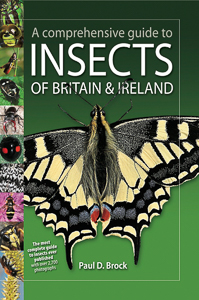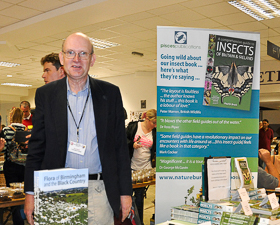Abstract: From the publisher: A comprehensive guide by Paul D. Brock, Scientific Associate of the Natural History Museum, London, and author of the acclaimed 'Photographic Guide to Insects of the New Forest' is the most complete guide to insects of Britain and Ireland ever produced with over 2700 full colour photographs and fully comprehensive sections on all insect groups, including flies, bees and wasps.
 |  |
| Front Cover | Back Cover |
by Paul Brock
A comprehensive guide to Insects of Britain & Ireland - by Paul D. Brock, Scientific Associate of the Natural History Museum, London, and author of the acclaimed 'Photographic Guide to Insects of the New Forest' is the most complete guide to insects of Britain and Ireland ever produced with over 2700 full colour photographs and fully comprehensive sections on all insect groups, including flies, bees and wasps.
Book details
ISBN: 978-1-874357-58-2
Size: 195 x 135mm
Pages: 528
Following on from Paul Brock's A Photographic Guide to Insects of the New Forest and Surrounding Area is his latest tome: "A Comprehensive Guide to Insects of Britain and Ireland". In my review of the former work I said "Don't be fooled by the title - many of the individual species are found across the British Isles and not just the New Forest area, and this guide will help you identify the family or even genus for those species found further afield for the most part". However, I may have spoken too soon since this new guide covers over 2,100 species (rather than the 1,300 of the New Forest) and is 528 pages (rather than 314). I take my hat off to the author and the production team for covering so much ground in such a short space of time! I particularly appreciate some of the changes that have been made to make the navigation easier - such as removing the key to each photo and placing the name of the species with each photo itself.
 |
As one would expect, the book is organised by the major orders, with a useful index to these in the inside cover and a corresponding easy-to-find colour-coded heading on every page for those wanting to find a particular creature. Each pair of pages contains species descriptions, distribution maps and excellent photos of the various species taken in their natural environment. Immature stages are also shown on occasion, together with the odd habitat shot. The book concludes with a set of references and a glossary. The layout of each pair of pages is perfect for flicking through the guide to quickly get to the section you're after, and I'm sure this is why the book is laid out the way it is - with species descriptions on the left hand page and photographs on the right.
 |
| The Author at the AES Exhibition |
Descriptions are provided for each order, family and species and are, for a guide of this scope, quite extensive and certainly more than enough for most enthusiasts without having to resort to a more-detailed and specialist book. Aside from the general descriptions, each order provides a summary of habitat, along with some pointers to "hotspots" and links to other resources where appropriate. Each species description then refines any habitat description and also gives details of both distribution and season (when the adults are out).
 |  |  |
| Mining Bees | Chafers | Soldierflies |
In terms of coverage, I'm sure that there will be species missing within some taxa but if, like me, you simply want to know what you're looking at (when out and about), then this guide will get you down to genus at a minimum (for all cases I tested the guide against). So, while the book's claim to being "A Comprehensive Guide to ..." could be questioned, it most certainly IS the most comprehensive around as far as I'm aware.
In summary, this book is the best of its kind bar none and I can't recommend it highly enough. Every entomologist should have a copy and, of course, it makes for a perfect stocking filler; I intend to make my wife and children aware of this review in due course.
The book can be ordered from Nature Bureau.